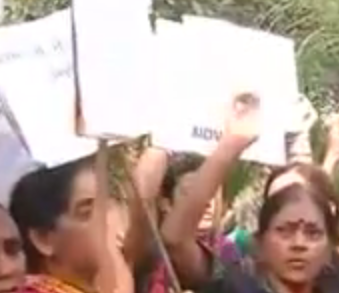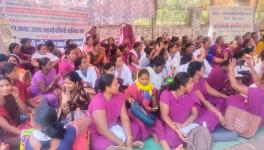Tubectomy Deaths in Chhattisgarh: Family Planning, Patriarchy and Public Health
In this interview, Jaya Velankar talks about the recent disaster at sterilisation camps in Chhattisgarh in which eleven women died and more than fifty were hospitalized. Highlighting the criminal negligence involved in the episode, she points out that the procedure violated several Supreme Court guidelines and international conventions. She locates these violations in a context where the poor and disempowered are regarded not as right-bearing citizens but merely as objects of control and manipulation. Family planning must shift from coercive target-based and camp-based approaches to voluntary contraception. This would be in consonance with the National Population Policy of 2000. Further, the burden of family planning and contraception is placed disproportionately on women. This patriarchal policy runs right from top officials to ground level workers. The need of the hour is to design and implement policies that ensure that men share responsibility equally with women. This would require, among other things, a thorough reshaping of educational practices and social perceptions. Finally, Jaya stresses that these problems cannot be meaningfully addressed without expanding the public health system.

Rough Transcript:
Arjun Sengputa: Hello and welcome to Newsclick. Today, we have with us Jaya Velankar from the Jan Swasthya Abhiyan and National Alliance for Maternal Health and Human Rights. We will be discussing with her the recent tragedy in the sterilization camps at Chattisgarh where more than 10 women lost their lives and over 50 were hospitalized. Jaya there have been different versions of what went wrong at those health camps, the sterilization camps. What according to you led to the tragedy.
Jaya Velankar: I would like to begin with the word tragedy. I don't think it is a tragedy. I think it is a murder because if you see the situation in spite of the Supreme Court guidelines, in spite of various protocols that the concerned ministries have come up in all states, in spite of that all the protocols were flouted. Supreme court guidelines say that in a day not more than 30 such surgeries takes place and one surgeon can not perform more than 10. Whereas we know in this case, less than five hours that surgeon performed 83 surgeries. It was a makeshift kind of a hospital. This time it happened in a hospital. But many times, such camps takes place in cow sheds, in makeshift places like school buildings. Here, it was hospital but which was not in use for last 15 years. So it was as good as a cow shed or a school building. So you can imagine what kind of hygienic conditions must be prevailing there. The other protocol says that the laparscopes, there should be at least 2 laparascopes. We don't know how many were used here. But one laparoscope after one surgery, should be dipped in the disinfected solution for 20 minutes. It should be stay in that solution for 20 minutes. Now, if you see and calculate for yourself. Every four minutes, one surgery was performed. So, obviously that 20 minute protocol was not adhered to. If this happens and the reports that are now coming in as per that surgeons claim, it was the spurious medicine which was tampered with some poisonous drug if that is responsible, so then that opens up questions like things about procurement of drugs. Who is responsible?
AS: You are talked about the breach of protocol. What according to you would be the priciple reason for breaches? Could it be the kind of pressure on doctors to show results on paper?. Or is it ignorance of these protocols or is it lack of requisite health infrastructure?
JV: All three plus and the biggest reason is virtually no value for these poor women. Poor women or men. Basically, they are considered to be the breeding cattles and anyhow that breeding has to be stopped. That is the logic and that comes from the top. If our development does not go from top to bottom, but this kind of policy and philosophy definitely trickles down. So right from the top till the ASHA worker, everybody is obsessed with catching these women and getting them tubectomised at any cost. They are given targets. We all know, these are unofficial, unwritten targets in spite of another international treaty that our government has signed. International conference on population and development that took place in 1994 in Cairo. 20 years we just had a government telling us what progress we have made and after that conference all the governments in the world agreed that it should be completely voluntary. Contraception should be voluntary, it should not be forced. So our government agreed for a target free approach. In spite of that, every year in some place or the other in the country these kinds of murders are taking place.
AS: Some people have pointed out that there is a big dis-balance between the number of tubectomies which are performed and the number of vasectomies. Some argue that vasectomy as a process is a comparatively easier. Why do you think this dis-balance persist and to what extent do you think dis-balance is responsible for episodes like these?
JV: There are two things. As you said, this is one of the simplest surgeries in the world. But not many men and women are informed about it. So there is a scare in peoples minds. It is also because of the excesses that happened during the emergency in 1975 and 76. Many men were forcibly sterilized and that was one of the reasons Indira Gandh lost here power. So after that no government, in fact all the governments have decided not to go that way. Not to even talk about vasectomy so that is one reason there is very little propaganda about vasectomy which is very very much needed. Having said that, let me warn you we, not for a minute would want to suggest that now you have camps for vasectomy. Camp approach itself is faulty. Faulty design because as I have explained, the same thing can explain in case of poor men and we do not want poor women now to be replaced with poor men being treated in this same way. What we are asking for is adherene to our national population policy that our government came up in 2000 which talks about complete voluntary choice. Voluntary contraception and no targets.
AS: In terms of voluntary contraception which you talked about what would be the way forward towards it? What are the different methods and approaches which one can adopt towards achieving such a goal?
JV: This is a question that needs a very long answer and there are multiple factors. It is not very simple. There are many methods and because of this kind of incident and that is also a fair need of the people to have spacing methods. But the spacing methods that are currently available that are also mainly oriented towards women. There are merits and demerits of each and every method. So, I would not like to go into that because it is really a vast subject and I can not deal with it in a very short time. But I would say that our society and our government has to really very seriously now put the onus of responsibility of contraception on men. For too long they have enjoyed escaping all that and it is always considered because of women gets pregnant and then she either has to go through abortion or the pregnancy and then the child care, she is forced to adopt one or the other method. She herself does not want many children. That is also one reason women themselves go to these kinds of camps. Now, men have to share the responsibility and whether it is condom, or later on a terminal method like vasectomy, they are simplest and most I should say side effect free kind of methods. We have to tell our boys right from the young age, in fact, men of all ages needs to be told and women also that every time a man has sex and he ejaculates, he can father a child. Whereas, a women is fertile only three days per month which means 36 days only in a year and you see the disproportionate burden of contraception that women suffer. For 365 years, either she has to take pills or she has to get intra-uterine device fitted or she has to take harmonal injections or has to suffer tubectomy and if tubectomy is not done in a proper way, then she has to suffer few other consequences and the men go, I mean their pleasure becomes more important. We have to tell everybody that men have to share. It is men every time they have sex they can father a child. So they have a greater responsibility and I think that should become cornerstone of our.. I would not say population policy because we are completely against population control. It should be voluntary choice of men and women so I would say that should be the cornerstone of our contraception policy.
AS: Apart from the question of gender dis-balance, to what extent you think, a general lack of spending on public health has affected the question of contraception?
JV: Well, I would say because of very poor health budgets, overall our health services suffer. In fact, our criticism is even if our government is spending say one Rupee, out of that one Rupee more than thirty paise go on family planning, as they call it family planning services and that is also very little for a country like us. So, the solution lies in the overall increase in the expenditure on health. No doubt. But currently, disproportionately whatever money is available is being spent on family planning that also has to stop.
AS: Thanks Jaya for that enlightening and useful discussion. She identified that changes at the top at the policy level we should bring it in line with international conventions which shifted towards more voluntary mode of contraception along with educational practices which shift the burden of contraception from women to men can go a long way in addressing the question of contraception, of family planning meaningfully, which can prevent the kind of incident, the kind of murder as Jaya referred to it from happening in the future. Thank you so much.
Get the latest reports & analysis with people's perspective on Protests, movements & deep analytical videos, discussions of the current affairs in your Telegram app. Subscribe to NewsClick's Telegram channel & get Real-Time updates on stories, as they get published on our website.
























